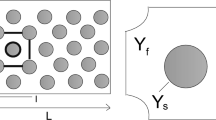Abstract
This paper shows the results of the smooth particle hydrodynamics (SPH) modelling of the hydraulic jump at an abrupt drop, where the transition from supercritical to subcritical flow is characterised by several flow patterns depending upon the inflow and tailwater conditions. SPH simulations are obtained by a pseudo-compressible XSPH scheme with pressure smoothing; turbulent stresses are represented either by an algebraic mixing-length model, or by a two-equation k-ε model. The numerical model is applied to analyse the occurrence of oscillatory flow conditions between two different jump types characterised by quasi-periodic oscillation, and the results are compared with experiments performed at the hydraulics laboratory of Bari Technical University. The purpose of this paper is to obtain a deeper understanding of the physical features of a flow which is in general difficult to be reproduced numerically, owing to its unstable character: in particular, vorticity and turbulent kinetic energy fields, velocity, water depth and pressure spectra downstream of the jump, and velocity and pressure cross-correlations can be computed and analysed.
Similar content being viewed by others
References
Pagliara S. Transition from supercritical to subcritical flow at an abrupt drop [J]. Journal of Hydraulic Research, 1992, 30(3): 428–432.
Nebbia G. Su taluni fenomeni alternativi in correnti libere [J] L’Energia Elettrica, 1942, XIX(1): 1–10.
Abdel Ghafar A., Mossa M., Petrillo A. Scour from flow downstream of a sluice gate after a horizontal apron [C]. 6th International Symposium on River Sedimentation-Management of Sediment-Philosophy, Aims, and Techniques, New Delhi, India, 1995, 1069–1088.
Mossa M. On the oscillating characteristics of hydraulic jumps [J]. Journal of Hydraulic Research, 1999, 37(4): 541–558.
Wang H., Chanson H. Experimental study of turbulent fluctuations in hydraulic jumps [J]. Journal of Hydraulic Engineering, ASCE, 2015, 141(7): 04015010.
Mossa M., Petrillo A., Chanson H. Tailwater level effects on flow conditions at an abrupt drop [J]. Journal of Hydraulic Research, 2003, 41(1): 39–51.
Dalrymple R. A., Rogers B. D. Numerical modelling of waves with the SPH method [J]. Coastal Engineering, 2006, 53(2-3): 131–147.
Capone T., Panizzo A., Monaghan J. J. SPH modelling of water waves generated by submarine landslides [J]. Journal of Hydraulic Research, 2010, 48(Suppl. 1): 80–84.
De Padova D., Dalrymple R. A., Mossa M. Analysis of the artificial viscosity in the smoothed particle hydrodynamics modelling of regular waves [J]. Journal of Hydraulic Research, 2014, 52(6): 836–848.
Espa P., Sibilla S., Gallati M. SPH simulations of a vertical 2-D liquid jet introduced from the bottom of a free-surface rectangular tank [J]. Advances Application Fluid Mechanics, 2008, 3(2): 105–140.
De Padova D., Mossa M., Sibilla S. et al. 3D SPH modelling of hydraulic jump in a very large channel [J]. Journal of Hydraulic Research, 2013, 51(2): 158–173.
Jonsson P., Andreassona P., Hellström J. G. I. et al. Smoothed particle hydrodynamic simulation of hydraulic jump using periodic open boundaries [J]. Applied Mathatical Modelling, 2016, 40(19-20): 8391–8405.
De Padova D., Mossa M., Sibilla S. SPH modelling of hydraulic jump oscillations at an abrupt drop [J]. Water, 2017, 90: 790–814.
De Padova D., Mossa M., Sibilla S. SPH numerical investigation of characteristics of hydraulic jumps [J]. Environmental Fluid Mechahics, 2017, https://doi.org/10.1007/s10652-017-9566-4.
De Padova D., Mossa M., Sibilla S. SPH numerical investigation of the velocity field and vorticity generation within a hydrofoil-induced spilling breaker [J]. Environmental Fluid Mechanics, 2016, 16(1): 267–287.
Mossa M., Tolve U. Flow visualization in bubbly twophase hydraulic jump [J]. Journal of Fluids Engineering, 1998, 120(1): 160–165.
Mossa M. Discussion on “Relation of surface roller eddy formation and surface fluctuation in hydraulic jumps” by K. M. Mok [J]. Journal of Hydraulic Research, 2005, 43(5): 588–592.
Mossa M., Petrillo A., Chanson H. Discussion on the “Tailwater level effects on flow conditions at an abrupt drop” [J]. Journal of Hydraulic Research, 2004, 43(2): 217–224.
Mossa M. Experimental study of the flow field with spilling type breaking [J]. Journal of Hydraulic Research, 2008, 46(Suppl. 1): 81–86.
Liu G. R., Liu M. B. Smoothed particle hydrodynamics: A meshfree particle methods [M]. Singapore: World Scientific, 2005.
Monaghan J. J. Simulating free surface flows with SPH [J]. Journal of Computational Physics, 1992, 110(2): 399–406.
Sibilla S. An algorithm to improve consistency in smoothed particle hydrodynamics [J]. Computers and Fluids, 2015, 118: 148–158.
De Padova D., Mossa M., Sibilla S. Laboratory experiments and SPH modelling of hydraulic jumps [C]. Proceedings of the 4th SPHERIC Workshop, Nantes, France, 2009, 255–257.
De Padova D., Mossa M., Sibilla S. et al. Hydraulic jump simulation by SPH [C]. Proceedings of the 5th SPHERIC Workshop, Manchester, UK, 2010, 50–55.
Launder B. E., Spalding D. B. The numerical computation of turbulent flows [J]. Computer Methods in Applied Mechanics and Engineering, 1974, 3(2): 269–289.
Dehnen W., Aly H. Improving convergence in smoothed particle hydrodynamics simulations without pairing instability [J]. Monthly Notices of the Royal Astronomical Society, 2012, 425(2): 1068–1082.
De Padova D., Dalrymple R. A., Mossa M. et al. An analysis of SPH smoothing function modelling a regular breaking wave [C]. Proceedings of the National Conference XXXI Convegno Nazionale di Idraulica e Costruzioni Idrauliche, Perugia, Italy, 2008.
Author information
Authors and Affiliations
Corresponding author
Rights and permissions
About this article
Cite this article
De Padova, D., Mossa, M. & Sibilla, S. SPH numerical investigation of the characteristics of an oscillating hydraulic jump at an abrupt drop. J Hydrodyn 30, 106–113 (2018). https://doi.org/10.1007/s42241-018-0011-z
Received:
Accepted:
Published:
Issue Date:
DOI: https://doi.org/10.1007/s42241-018-0011-z




